The Land of Papua has got more than one thousand big and small islands in its surroundings. Raja Ampat archipelago, which is located in the western end region of the Land of Papua, consists of 4 big islands, i.e. Waigeo; Batanta; Salawati; Misool, as well as hundreds of smaller islands.
This extraordinary archipelago supports the richest coral reef, and rainforest environments. Raja Ampat's marine biodiversity is the highest in the world. There are 1,427 reef fishes, 553 hard corals and 42 species of mantis shrimp (See Reference 1 at footnote). The easiest way to see the beauty of this abundant marine life is by swimming, snorkeling or scuba diving.
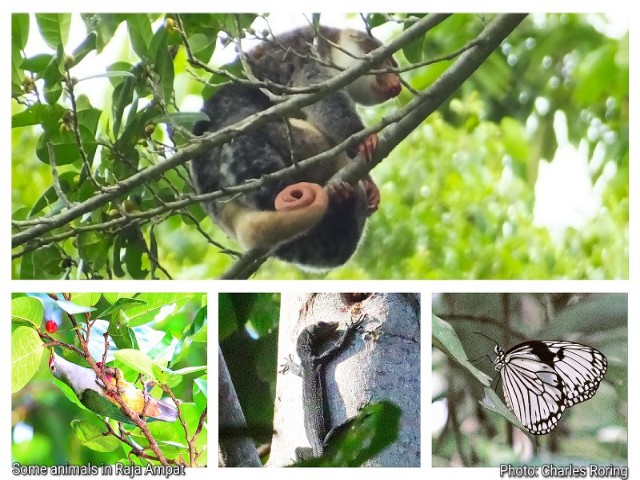

Its beaches are also the nesting ground of sea turtles including Green Turtles, Leatherback Turtles, Olive Ridley and Hawksbill turtles.
Raja Ampat has got a lot of endemic marine fish species including Hemiscyllium freycineti which is also called bamboo shark; Paracheilinus nursalim - a flasher wrasse; Eviota raja - a coral goby; Chromis athena - Gold-crested Damsel; Vamderhorstia sp - Wayag shrimp goby; Pseudochromis sp. 2 - Wayag dottyback, and etc.
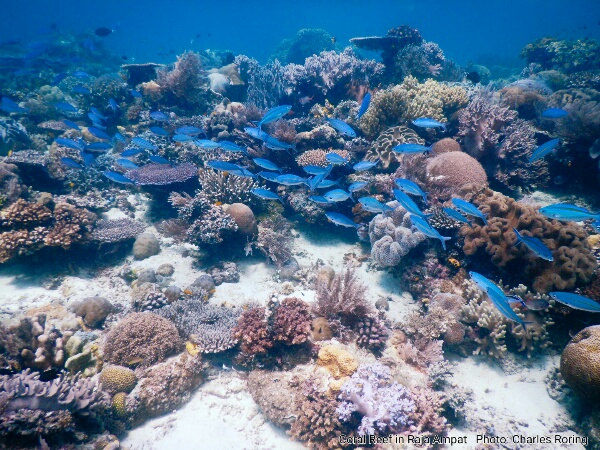
The tropical rainforest of Waigeo is the habitat of various species of plants, and animals. Trees with high economic value including a lot of fruiting and commodity trees such as nutmeg, canarium, coconut, betelnut, breadfruit tree, and matoa tree. The ones whose wood are used in building construction include Iron-wood or Merbau tree (Intsia bijuga), Matoa (Pometia pinnata). The stem of Kayu Gatal tree (Pertusadina eurhyncha) is commonly used as pillars for a wooden jetty at the beach because its wood is resistant to sea water and tiny wood boring creatures at the beach. There are orchid, nepenthes, and hibiscus in Raja Ampat too.
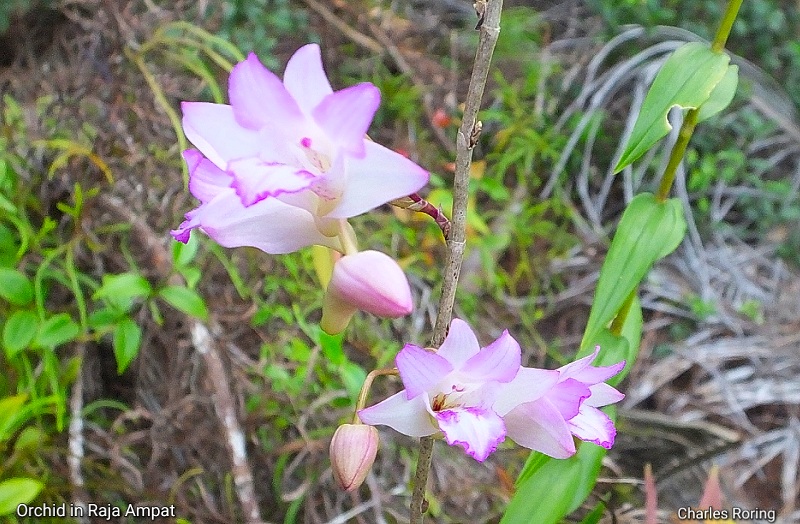
There are a number of endemic birds such as Red Bird of Paradise (Paradisaea rubra), Wilson's Bird of Paradise (Diphyllodes respublica), and Waigeo Brushturkey also called Bruijn Brushturkey (Aepypodius bruijnii), Raja Ampat Pitohui (Pitohui cerviniventris). In other islands, there are Kofiau Paradise Kingfisher, Kofiau Monarch; and Spice Imperial Pigeon (which also lives in nearby Maluku islands), Yellow-faced Myna.

In addition to birds, the forest of Raja Ampat is the habitat of other animals including reptiles, mammals, amphibious animals, and insects. Narrow-mouthed frog, White-lipped Tree Frog, Mangrove Skink, Blue-tounged Skink, Green Tree Skink, Blue-tailed Skink, Common Tree Snake, and Green-tree Python.
Hundreds of species of tropical birds in mainland New Guinea can also be found in Raja Ampat islands. Some of them are Rufous-bellied Kookaburra, Hook-billed Kingfisher, Common Paradise Kingfisher, Wallace's Owlet-nightjar, Large-tailed Nightjar, Papuan Boobook, Papuan Frogmouth, Marbled Frogmouth, Olive-crowned Flowerpecker, Lowland Peltop, Black-capped Lory, Red-flanked Lorikeet, Eclectus Parrot, Palm Cockatoo, Sulphur-crested Cockatoo, Wompoo Fruit Dove, Beautiful Fruit Dove, and Great Cuckoo Dove.
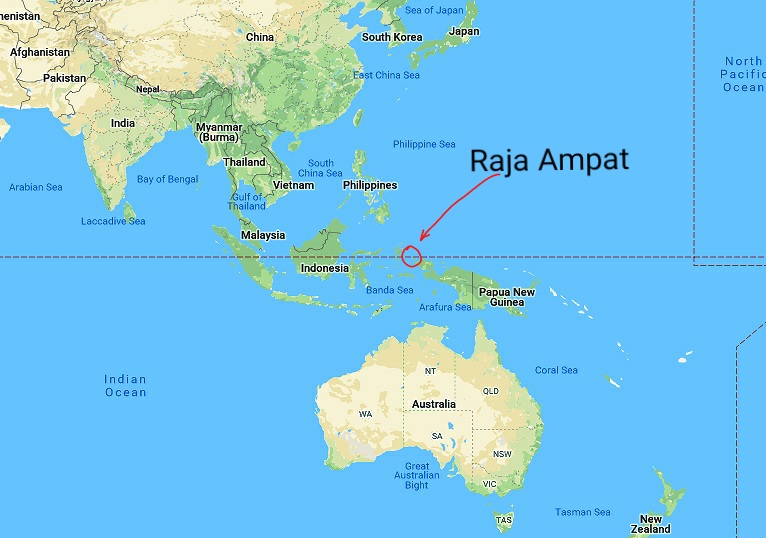
Where to see marine animals in Raja Ampat?
Visitors who are marine lovers will definitely want to see all these marine animals. There are plenty of beaches with coral reef sites that are suitable for visitors who like snorkeling and scuba diving. An easy to reach beach for snorkeling from the Port of Waisai is Warduwer beach where Raflow Beach Resort is located. The house-reef of the resort is the habitat of parrotfish, surgeonfish, frogfish and even the Raja Ampat's Tasseled Wobbegong Shark. Visitors can go there by ojek (motorcycle taxi) or car.
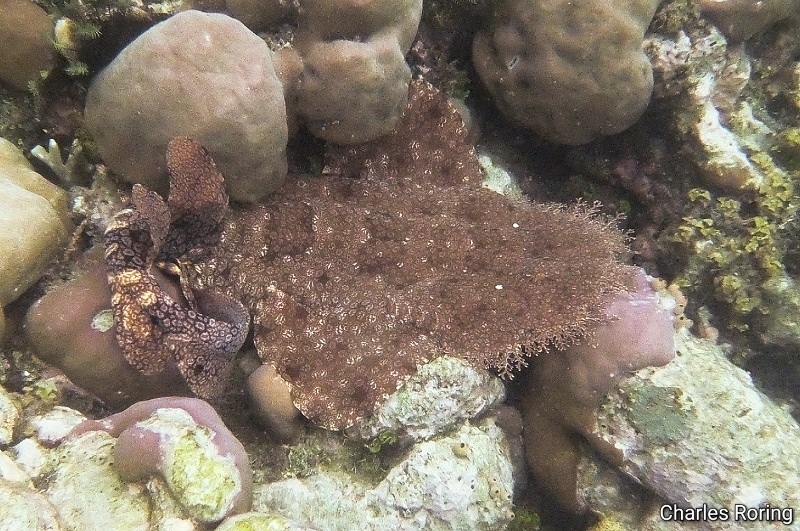
Another tourist attraction in Raja Ampat is Manta. There are several manta points in the archipelago. The famous one is located near Arborek island. Scuba divers, snorkelers and freedivers like to visit the manta point to see the giant fish that come to the place to have their body cleaned by a lot of small fish from the nearby rocks.
The beach resort is also a nice base for visitors who like to watch birds such as Palm Cockatoo, Sulphur-crested Cockatoo, Pinon Imperial Pigeon, Rufous-bellied Kookaburra, Beach Kingfisher, Willie Wagtail, Blyth's Hornbill, Helmetted Friarbird, Hooded Butcherbird, and a lot more.
In northeast coast of Waigeo, leatherback, green, olive ridley turtles land to lay eggs every year.
Kabui Bay has got several coral reef sites especially the house-reef in front of Yengkawe homestay, Wilson Homestay, Yensner Homestay, Urai Kecil Island, Urai Besar Island. On the other side, which is Gam island where Raja Ampat Biodiversity Nature Resort, Yenros Homestay, are located the coral reefs are also in very good condition. Visitors need to go there by speedboat.
More coral reef sites can be explored in Kri, Mansuar, Batanta, Arborek, Fam islands, Piaynemo, Batangpele Islands, and Wayag islands, Kofiau, Kepulauan Sembilan (also called Nusela) and the last but not the least - the Misool islands. Most of the important coral reef sites that have got very high biodiversity are listed as Marine Protected Areas. This is written by Charles Roring
References:
- Diving Indonesia's Bird's Head Sescape - Burt Jones & Maurine Shimlock - Saritaksu Editions - 2011
- Ekologi Papua - Kartikasari, A. K. Marshall, B.M. Beehler - Yayasan Pustaka Obor Indonesia 2007